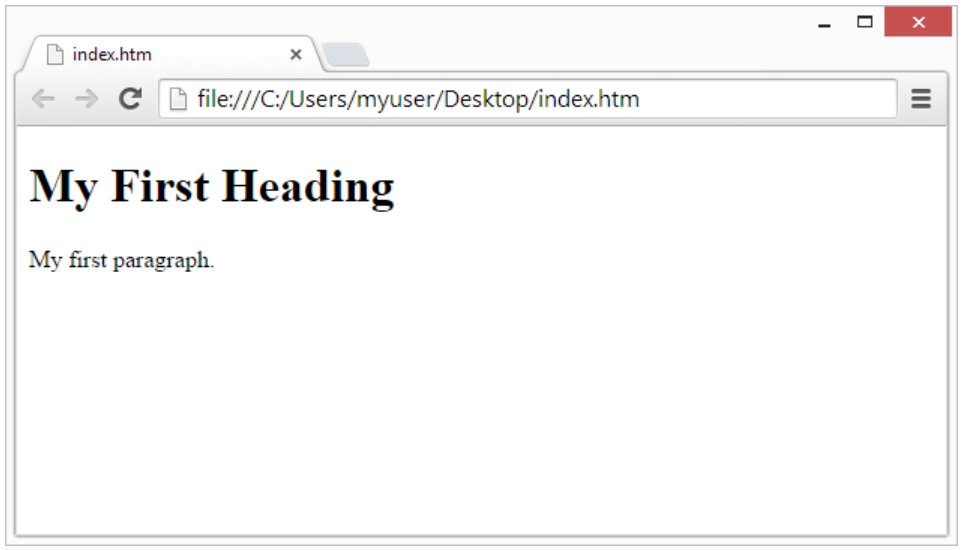HTML Introduction
HTML Introduction
The common markup language for making websites is HTML.
What is HTML?
- HTML is known as HyperText Markup Language.
- The common markup language used to create webpages is HTML.
- The structure of a web page is described in HTML.
- Several elements make up HTML.
- The content presentation in a browser is determined by HTML components.
- HTML components designate content with labels like “this is a title,” “this is a sentence,” “this is a data,” and so forth.
A Simple HTML Document
Example
<!DOCTYPE html>
<html>
<head>
<title> Title Of Page</title>
</head>
<body>
<h1> This is a Title.</h1>
<p>This is a sentence.</p>
<script>class RocketElementorAnimation{constructor(){this.deviceMode=document.createElement("span"),this.deviceMode.id="elementor-device-mode",this.deviceMode.setAttribute("class","elementor-screen-only"),document.body.appendChild(this.deviceMode)}_detectAnimations(){let t=getComputedStyle(this.deviceMode,":after").content.replace(/"/g,"");this.animationSettingKeys=this._listAnimationSettingsKeys(t),document.querySelectorAll(".elementor-invisible[data-settings]").forEach(t=>{const e=t.getBoundingClientRect();if(e.bottom>=0&&e.top<=window.innerHeight)try{this._animateElement(t)}catch(t){}})}_animateElement(t){const e=JSON.parse(t.dataset.settings),i=e._animation_delay||e.animation_delay||0,n=e[this.animationSettingKeys.find(t=>e[t])];if("none"===n)return void t.classList.remove("elementor-invisible");t.classList.remove(n),this.currentAnimation&&t.classList.remove(this.currentAnimation),this.currentAnimation=n;let s=setTimeout(()=>{t.classList.remove("elementor-invisible"),t.classList.add("animated",n),this._removeAnimationSettings(t,e)},i);window.addEventListener("rocket-startLoading",function(){clearTimeout(s)})}_listAnimationSettingsKeys(t="mobile"){const e=[""];switch(t){case"mobile":e.unshift("_mobile");case"tablet":e.unshift("_tablet");case"desktop":e.unshift("_desktop")}const i=[];return["animation","_animation"].forEach(t=>{e.forEach(e=>{i.push(t+e)})}),i}_removeAnimationSettings(t,e){this._listAnimationSettingsKeys().forEach(t=>delete e[t]),t.dataset.settings=JSON.stringify(e)}static run(){const t=new RocketElementorAnimation;requestAnimationFrame(t._detectAnimations.bind(t))}}document.addEventListener("DOMContentLoaded",RocketElementorAnimation.run);</script></body>
</html>
Example Explained
- This document is an HTML5 document, as defined by the <!DOCTYPE html> declaration.
- The root element of an HTML page is the <html> element.
- Metadata about the HTML page is contained in the <head> element.
- The title of the HTML page is specified by the <title> element and appears in the title bar or tab of the browser.
- All of the visible elements, including headings, paragraphs, graphics, hyperlinks, tables, lists, and so on, are contained within the <body> element, which constitutes the body of the document.
- An extensive heading is defined by the <h1> element.
- Chapters are defined by the <p> element.
What is an HTML Element?
An HTML element consists of an end tag, some content, and a start tag.
<tagname> Content is placed here. </tagname>
From the start tag to the end tag, everything is an HTML element :
<h1>My Opening Heading</h1>
<p>the opening paragraph of mine.</p>
| Start tag | Element content | End tag |
|---|---|---|
| <h1> | My Opening Heading | </h1> |
| <p> | the opening paragraph of mine | </p> |
| <br> | none | none |
Web Browsers
The purpose of a web browser (Chrome, Edge, Firefox, Safari) is to read HTML documents and display them correctly.
A browser does not display the HTML tags, but uses them to determine how to display the document:

HTML Page Structure
Below is a figure of an HTML page structure:
HTML
HTML home
HTML tutorials
Learn HTML
Free HTML tutorials
HTML Example
HTML Explained
Hyper text Markup Language
In the ever-evolving landscape of web development, mastering HTML is essential for anyone looking to build a successful career in the field. Understanding the fundamentals of HTML not only allows you to create visually appealing websites but also ensures optimal performance across different devices. With a plethora of free HTML tutorials available online, aspiring developers have access to resources that can help them hone their skills and stay ahead in this competitive industry.
One of the key aspects of learning HTML is understanding how to structure content effectively using elements like headings, paragraphs, and lists. By grasping these foundational concepts, you can create well-organized and responsive websites that provide an exceptional user experience. Additionally, diving into more advanced topics such as forms and multimedia integration will elevate your coding abilities and enable you to unleash your creativity when designing web pages. As you embark on your journey to learn HTML, remember that practice makes perfect – experimenting with different codes and designs will refine your skills and help you become a proficient developer in no time.
In the vast landscape of web development, HTML stands as the cornerstone of creating engaging and interactive websites. Mastering HTML is like having the key to unlock a world of limitless possibilities in designing and building web pages. Through structured HTML tutorials, beginners can seamlessly progress from understanding basic tags to creating complex layouts with ease.
One of the intriguing aspects of learning HTML is its ability to bridge creativity and logic. By harnessing the power of HTML, individuals can craft visually appealing websites while also ensuring optimal functionality and accessibility for users. The beauty of HTML lies in its simplicity yet profound impact – a testament to how essential this language is in shaping our online experiences.
With an abundance of free online resources available, diving into an HTML course has never been more accessible. Embracing these tutorials not only opens doors to new skills but also empowers individuals to express their unique ideas on the digital canvas that is the World Wide Web. Whether you’re looking to create your dream website or embark on a new career path in web development, learning HTML is undoubtedly a transformative journey worth embarking on today!

